REBUS (レブス), released 3/26/1998, developed and released by ATLUS
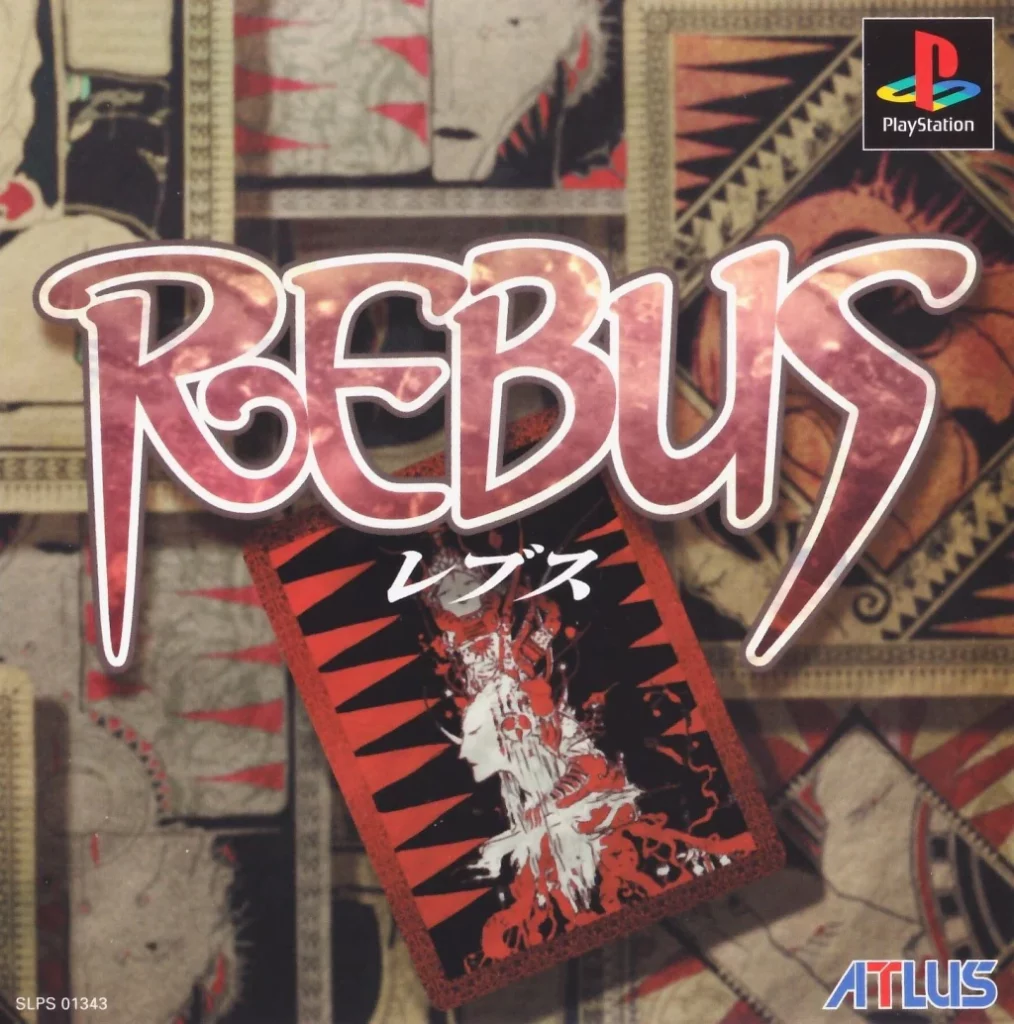
Two Atlus games in a row. This is Atlus’ first SRPG that isn’t in the Megami Tensei franchise, although it still involves summoning monsters. It was localized in the US as “Kartia: The Word of Fate”. In a coincidence, a twitch streamer I follow named Karkalla has just started the game on Friday and should be playing it for a couple of weeks.
The art was done by Yoshitaka Amano, well known for his Final Fantasy illustrations that go against the typical anime style that you normally see in JRPGs. Now that we are in the fifth generation of consoles, Amano’s art can actually be directly used in the game rather than simply providing art for the instruction manuals that isn’t reflected anywhere in the actual game.
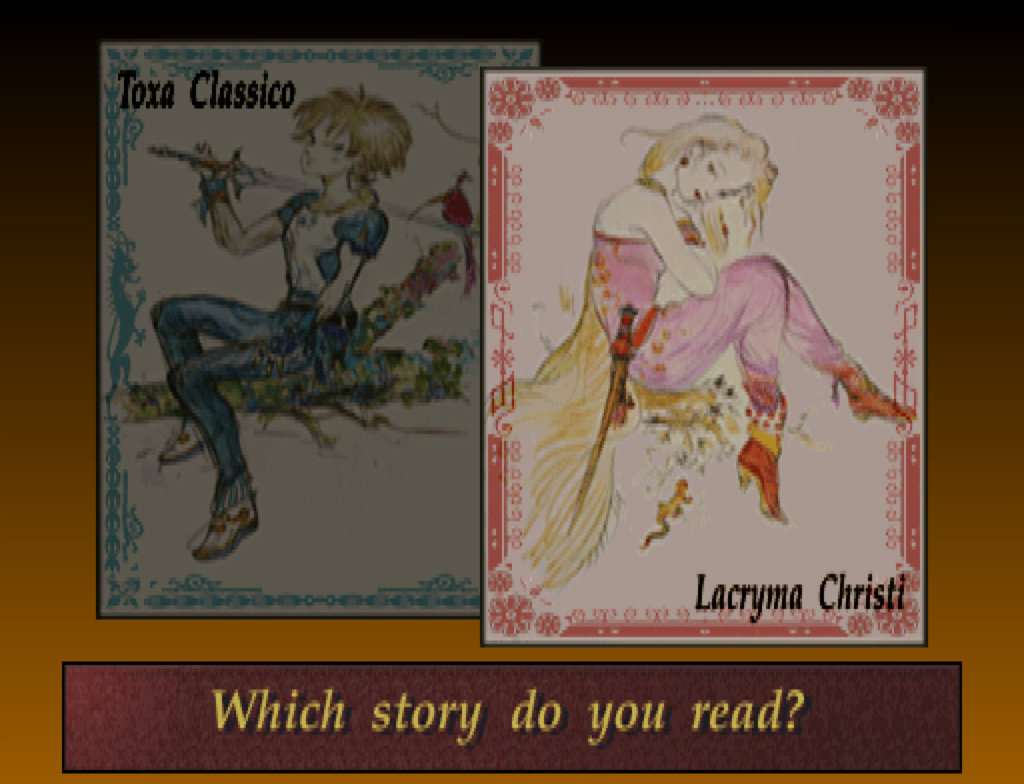
The story is presented in an unusual fashion. There are two protagonists with 18 chapters each, but the story is laid out in a total of 36 episodes that weave back and forth between the stories. There is a lot of overlap and interaction between the two stories and they are basically telling two parts of the same tale. You can either play one all the way through and then the other, or play episode order which requires you to switch back and forth between the two. The latter is what I did.
The game takes place in a world that is strongly controlled by a church — the terms “heresy” and “heretic” are constantly used in the game of people who question the church’s teaching, or even non-humans. There are a group of “inquisitors” who are given extra-judicial and extra-national powers to hunt down and punish heresy. The English translation blunted these terms by using “inquirer” and “heathen”. I don’t know if this was a conscious decision or if it was simply ignorance of the translators for what the terms mean. It can be something of a challenge to deal with this kind of thing because Japanese games frequently use terms that were originally coined to refer to the Catholic Church, but they are then applied to any fictional religion that is sort of Christian-like. Translators perhaps want to avoid the strongly loaded Catholic terms to avoid giving a connotation to the terms that they don’t have in Japanese, but I don’t know whether they think of it this closely.
Lacryma Christi, the woman protagonist, is a Holy Knight devoted to the church, with a strong belief in its teachings. She’s the daughter of Cainas, a deceased hero, and is revered as a holy woman. Toxa is the son of a merchant who dreams of being a knight. Both are involved with the local guard of the Crossland kingdom, operating in the Shinon barony. The story first involves fighting against a bandit group, but soon expands to involve a plot by certain people in the church to summon the holy land of Eden.
The story and characters are definitely a strong point of the game. Each character gets a fair amount of time and development, and the overall story is interesting as well. Amano’s art is also memorable in highlighting the characters.
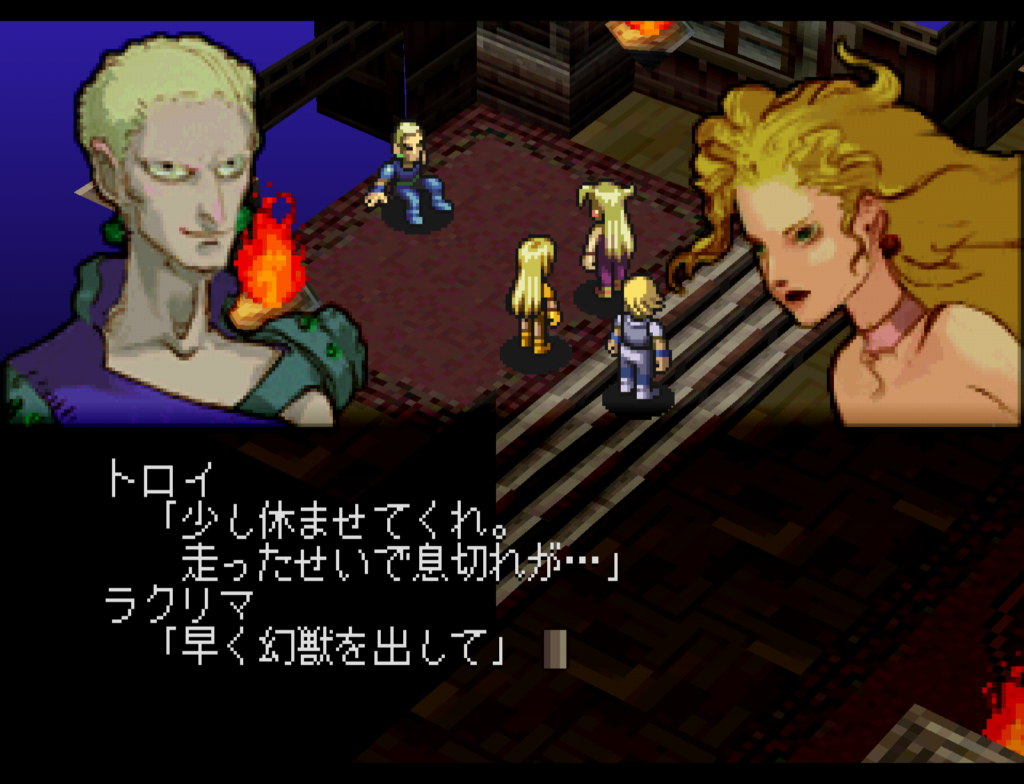
The other worldbuilding aspect that has more to do with the system is Kartia. These are a type of card that people can use to “imagine” things, writing them on the materials to make them appear. They are used for a lot of things in the world, but all of the “texts” are copies of the Originals that can be used for great power, although often at a great cost to the user.
In terms of the system, you find “texts” in the stages (either from beating enemies, opening chests, or burning barrels/boxes/etc, or as a stage reward). These texts can be combined to do three primary things, and each use takes one or more of your materials (Silk, Mithril, or World Tree).
Most of the combinations are given to you and you just have to select them, but you can usually add additional texts to increase the power. For the most part the additional texts you add just up the power without any relevance to what the text actually is (each one is a kanji character), but there are a few hidden combinations that can make additional items not listed.

The first thing you can do with the kartia is make equipment. There are no shops in the game so this is the only way to get new equipment other than finding it in a stage. There are six types of weapons, and six armors (two head, two body, two leg/foot).
The second thing you can do is cast spells. It doesn’t look like I took a screenshot of that, but the spells window is similar to the others — you pick a base spell (which are sorted into about 8-10 basic types) and then you can add additional texts to increase the power. The different classes of spells are elemental types, some of which have AoE, can heal, or burn things, raise and lower the ground, etc. There are no buff or debuff spells.
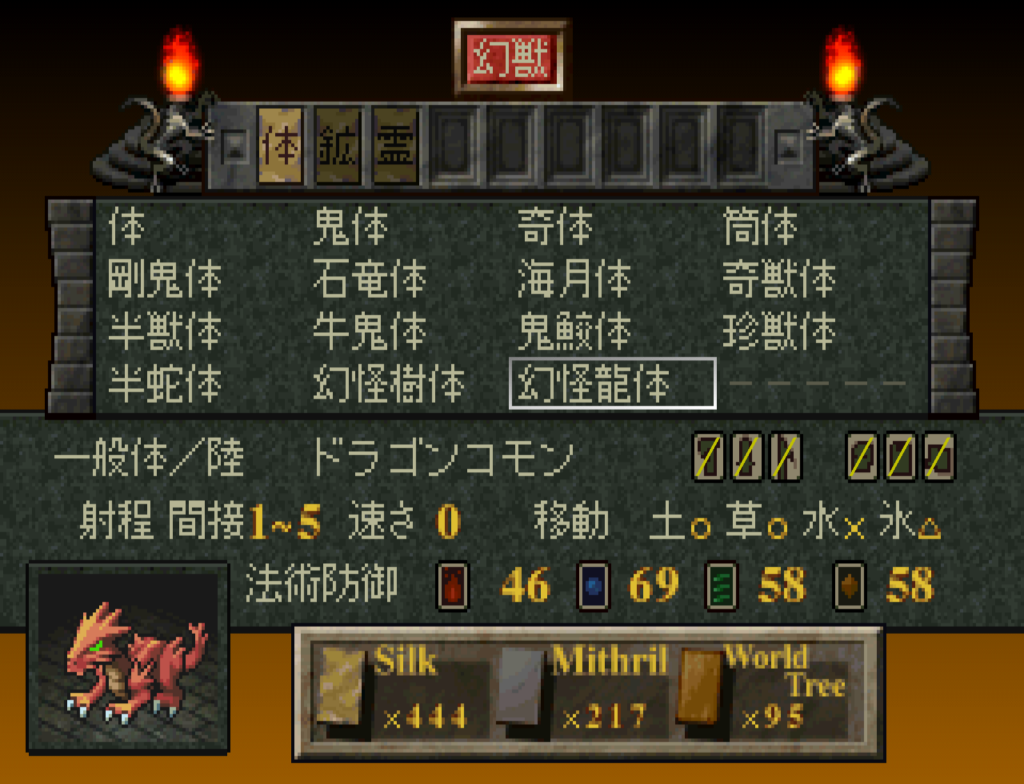
The third thing you do is summon Phantoms (幻獣). These are summoned monsters that can fight alongside you. They come in three basic types, and the types operate on a rock-paper-scissors system (which applies only to the phantoms themselves, not the human characters). They can gain levels and equip things, but if they reach 0 hp they die and cannot be revived. You can summon them before a battle starts, or use certain characters’ turns to summon them during battle (although they appear with their turn already used).
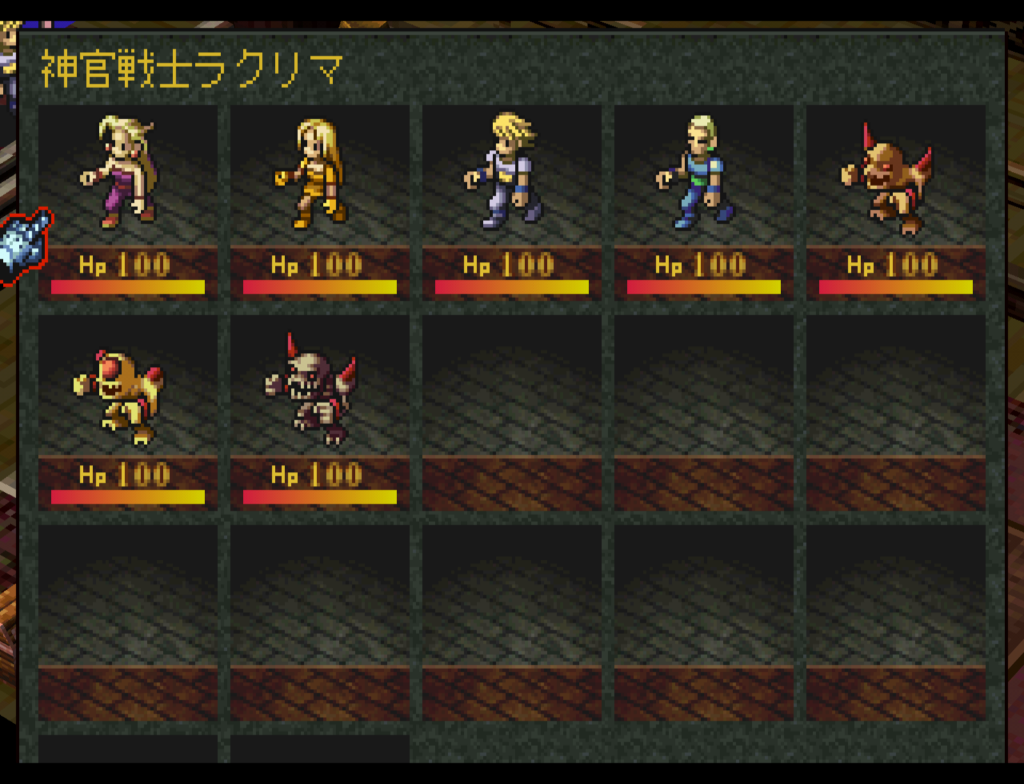
Each route is made up of 18 stages, played back to back with no alternate routes or anything in between the battles (other than story scenes). The only thing you can do between stages is play the Arena, where you are provided with a stock of monsters to fight against a group of enemies. You can’t gain XP here, only Kartia materials. I never used it.
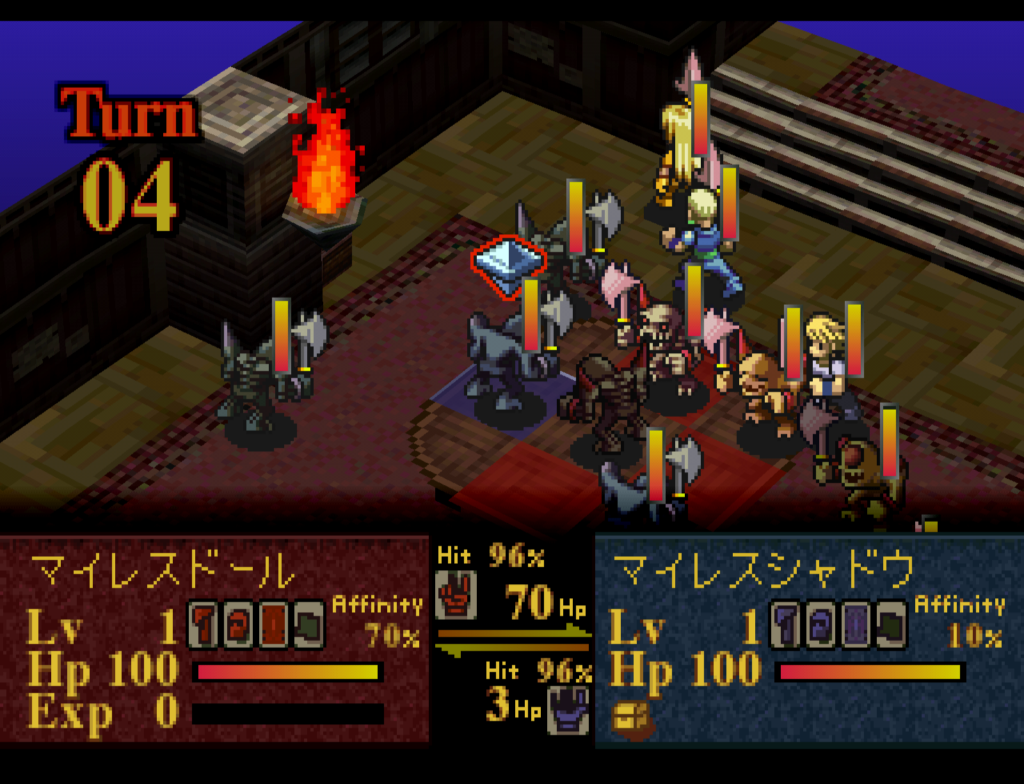
The battle system is relatively complicated with a lot of moving parts. In addition to the RPS system with the monsters that I mentioned before, height makes a big difference in weapons and armor. Spears work better when attacking from below, and axes work better when attacking from above. Helmets protect better against attacks from above, etc. Characters can counter attack unless they are ranged attackers. You can use Quake to raise and lower the ground.
The system has two aspects that I do not like. First, any human character reaching 0 hp means a game over. This means you have to be aware of letting monsters gang up on your guys. Second, the lower a character’s HP, the worse they fight. This is a system that is not commonly used in games, and I never like it when it is. It may be realistic but it’s not very fun.

The Phantoms are a big problem in the game. They are extremely difficult to keep alive. They always start at level 1, and because the RPS system has such a huge effect, it’s very difficult to keep them from getting killed by opposing monsters who have good compatibility with them. However, they are very cheap to summon, so especially early on in the game they can be used profitably as cannon fodder. I never had one higher than level 2, but I wonder how effective one would be if you actually managed to get them to a high level and equip them with some decent stuff.
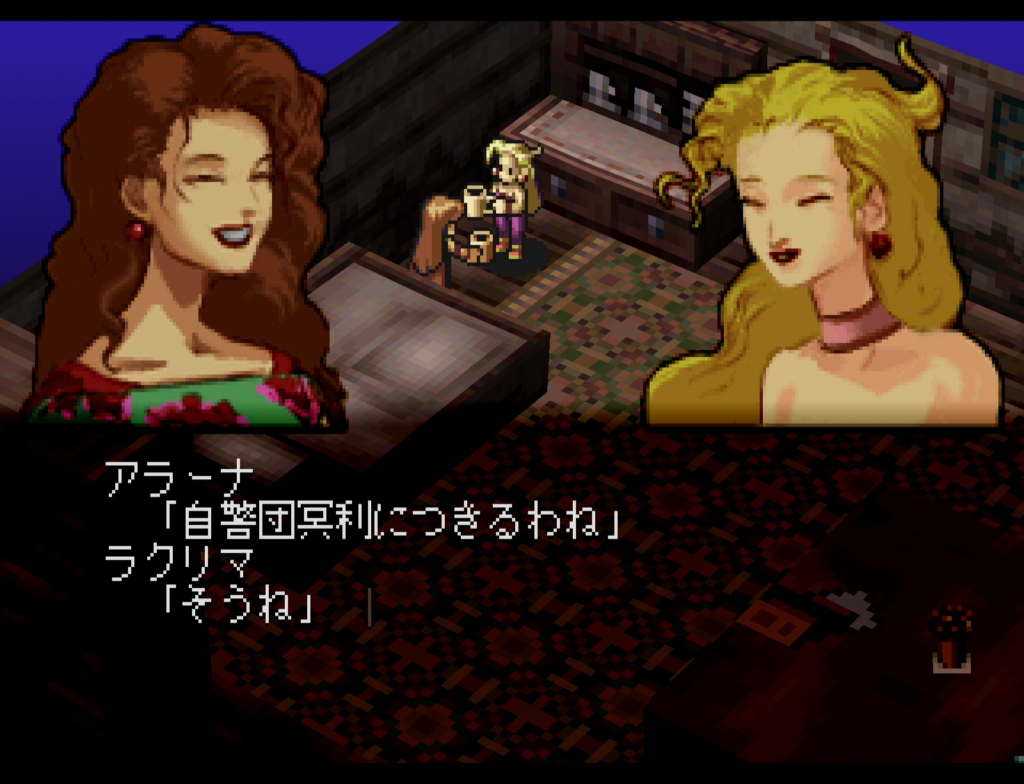
However, it’s not particularly relevant because after the first 4 or 5 stages, the game is extremely easy. Your human characters quickly reach a level where the enemies can’t do much against you even if they gang up on you, and you can defeat almost any enemy with just a few hits. There are still a couple of situations that are easier if you summon some monsters, and the final bosses take a little bit of strategy (particularly on Toxa’s route), but for the most part you can just send in your human characters with swords and slice through everything.
Which was fine, because I found the system more cumbersome than fun, and so it was nice to be able to enjoy the story without having to worry too much about the battles. From what I can see, my opinion of “good story, meh gameplay” seems to be shared by most of the reviewers in both English and Japanese.
One other aspect that is commented on a lot is that because you can’t repeat stages, many of the Texts in the game are permanently missable. You definitely want to make sure that when possible, you do not clear the stage without getting all the chests and boxes/barrels, and defeating any enemies that are carrying Texts. There are also hidden items in the stages but I didn’t bother with any of them.
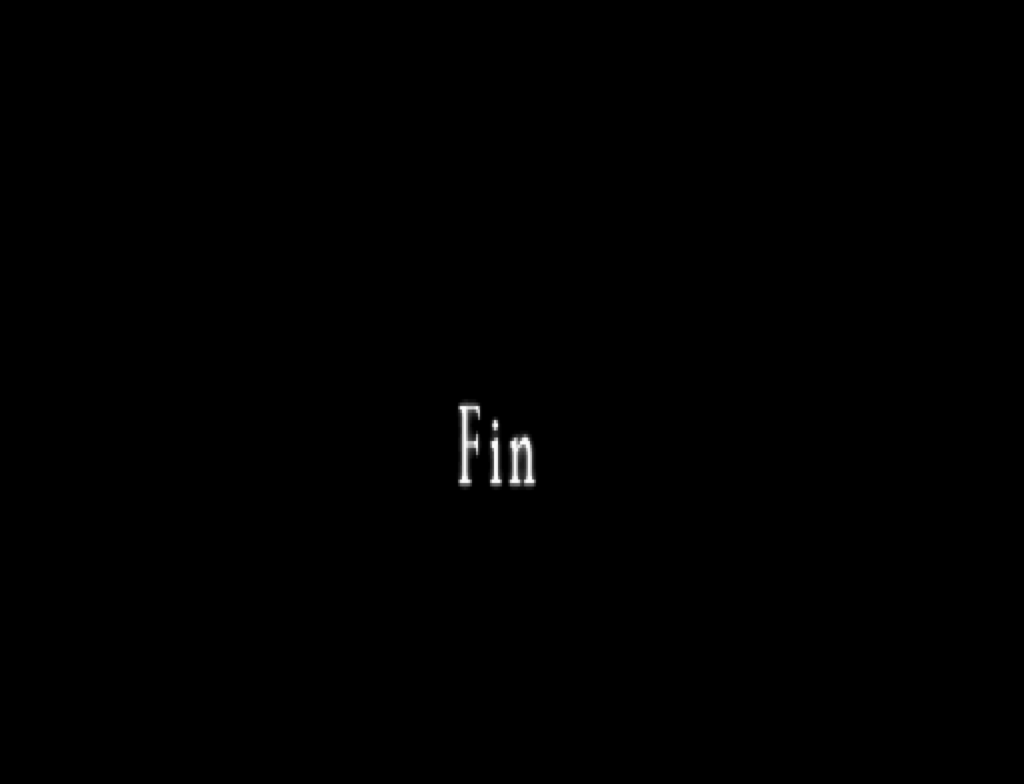
So overall this is an OK game, but give it a pass if you insist on having good gameplay — I do wonder what it would be like to play a game where you really try as hard as possible to build an army of the summoned phantoms. I have a feeling it would be more frustrating than anything else. I wish they could have made the phantoms more costly to summon, but have their levels and stats continue — unfortunately the disposable nature of the Phantoms is part of the plot.
The next random game I chose was another SRPG so next week will be Esper Dream for the Famicom Disk System.
Wow, somehow I missed that Atlus actually developed this one. Doesn’t feel that long ago that I thought Atlus was just a US publisher, and Persona was one of their more obscure titles.
This one sounds really cool. I’m sure its not as fully featured as this, but the card system sounds a lot like the spell system in Dungeon Master. I was always disappointed nobody followed up much on that.
> It can be something of a challenge to deal with this kind of thing because Japanese games frequently use terms that were originally coined to refer to the Catholic Church, but they are then applied to any fictional religion that is sort of Christian-like
I’ve always found it a bit curious how many JRPGs make some not-so-subtle jabs at Christianity and/or the Catholic Church: FF6, Luminous Arc, Kartia, Tactics Ogre, FE10, Disgaea and La Pucelle, the list goes on.
> the lower a character’s HP, the worse they fight. This is a system that is not commonly used in games, and I never like it when it is.
I’m surprised you didn’t comment more on the Langrisser influence, because this is one of many ways in which Kartia feels quite derivative of Langrisser (probably why I like Kartia so much!). The 100 HP system is basically the 10 HP system but with less variance; there’s the RPS system which was pioneered by Langrissers 1 and 2; phantoms are akin to troops in Langrisser; and you also have the multi-route story, Der Langrisser being the first SRPG to ever do something like that.
To me, Kartia felt like a nice fusion between the best parts of Langrisser and Front Mission, with some additional secret sauce to keep things spicy. I love the Kartia system and how you can create phantoms, weapons, and other equipment. There’s a lot of meat to the game underneath the surface, for those willing to take the time and minmax things. Yet it’s not needlessly obtuse either.
> The Phantoms are a big problem in the game. They are extremely difficult to keep alive. They always start at level 1
IIRC, you can summon progressively more powerful phantoms as the game goes on, so this isn’t a huge issue. I remember my rarer phantoms (towards the lategame) being pretty strong even at level 1. Plus, the phantoms that you summon CAN level up.
Probably my biggest problem with Kartia was the translation. It was still understandable, but then you had goofy lines like “A troops reach to Town of Kainas After a non-stop journey” or “I don’t think were going to get along…” But aside from this, I thought it was a pretty awesome game. I appreciated how its influences were fairly clear, but it managed to also do its own thing, create exciting and innovative systems of its own, and do more than just be a “clone” of something else.
I guess I didn’t really notice the Langrisser influence.
I wouldn’t really call this game a “multi route” story in the way that Der Langrisser was; you don’t have any choices or change the outcome at all. It’s more like Rudra no Hihou where you have an interlacing story that you can choose to follow in multiple ways.
JRPGs do draw on the “corrupt church” theme a lot — my impression is that this isn’t meant as an actual pointed critique of the Catholic Church but just a useful trope that makes an interesting story.